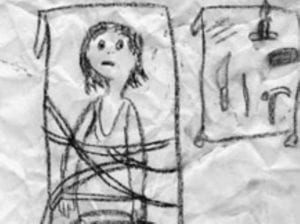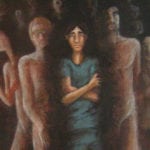10Louis Vivet
One of the first recorded cases of multiple personalities belonged to Frenchman Louis Vivet. Born to a prostitute on February 12, 1863, Vivet was neglected as a child. By the time he was eight, he had turned to crime. He was arrested and lived in a house of treatment into his late teens. When he was 17 years old, he worked in a vineyard, and a viper wrapped itself around his left arm. While the viper didn’t bite him, it terrified him so much that he had convulsions and psychosomatically became paralyzed from the waist down. While paralyzed, he was housed in an asylum, but he started walking again after a year. Vivet now seemed like a completely different person. He didn’t recognize any of the people at the asylum, his mood was much darker, and even his appetite was different.[2] When he was 18, he was released from the asylum but didn’t stay out long. Over the next several years, Vivet was in and out of hospitals. During a stay between 1880 and 1881, he was diagnosed with multiple personalities. Using hypnosis and metallotherapy (placing magnets and other metals on the body), a doctor discovered up to 10 different personalities, all with their own traits and history. However, upon reviewing the case in later years, some experts believe he may have only had three personalities.[3]
9Judy Castelli
Growing up in New York State, Judy Castelli suffered physical and sexual abuse, and afterward, she struggled with depression. A month after she enrolled in college in 1967, she was sent home by the school psychiatrist. Over the next several years, Castelli struggled with voices inside her head telling her to burn and cut herself. She nearly ruined her face, almost lost sight in one eye, and almost lost the use of one of her arms. She was also hospitalized several times for suicide attempts. Each time, she was diagnosed with chronic undifferentiated schizophrenia. In the 1980s, she began singing in clubs and cafes in Greenwich Village. She almost got signed to a record label, but that fell through. However, she was able to find work and headlined a successful off-Broadway show. She also found success in sculpting and making stained glass. Then, during a therapy session in 1994 with the therapist she’d had for over a decade, multiple personalities started to emerge, seven at first. As she continued her therapy, 44 personalities appeared.[4] Since finding out that she has DID, Castelli has become a strong advocate for the disorder. She was on the board of the New York Society for the Study of Multiple Personality and Dissociation. She continues to work as an artist and teaches art to people with mental illness.
8Robert Oxnam
Robert Oxnam is a distinguished American scholar who has spent his life studying Chinese culture. He is a former college professor, the former president of the Asian Society, and currently a private consultant for matters regarding China. While he is quite accomplished, Oxnam has struggled with his mental health. In 1989, a psychiatrist diagnosed him with alcoholism. That changed after a session in March 1990, when Oxnam planned to leave therapy. While speaking with Oxnam, the doctor was addressed by one of his personalities, a young, angry boy named Tommy, who lived in a castle. After that session, Oxnam and his psychiatrist continued their therapy and found that Oxnam actually had 11 separate personalities. After years of treatment, Oxnam and his psychiatrist whittled down the personalities to just three. There is Robert, or Bob, who is the core personality. Then there is Bobby, a younger, quizzical, free-spirited man who loves rollerblading in Central Park. Another is a “Buddhist-like” personality known as Wanda. Wanda used to be part of another personality known as the Witch.[5] Oxnam wrote a memoir about his life titled A Fractured Mind: My Life With Multiple Personality Disorder. It was published in 2005.[6]
7Kim Noble
Born in the United Kingdom in 1960, Kim Noble says her parents were factory workers who were unhappily married. From a young age, she was physically abused, and then she suffered from many mental problems as a teenager. She overdosed a few times and was placed in a mental institution. In her twenties, her other personalities emerged, and they were incredibly destructive. Kim was a van driver, and one of her personalities named Julie took over her body and plowed the van into a bunch of parked cars. She also somehow got involved in a pedophile ring. She went to the police with information, and when she did, she started receiving anonymous threats. Then someone threw acid in her face and set her house on fire. She couldn’t remember anything about the incidents.[7] In 1995, Noble was diagnosed with dissociative identity disorder, and she has been getting psychiatric help ever since. She is currently working as an artist, and while she does not know the exact number of personalities she has, she thinks it is somewhere around 100. She goes through about four or five different personalities a day, with Patricia being the most dominant one. Patricia is a calm, confident woman. Another notable personality is Hayley, the one involved with the pedophile ring that led to the acid attack and the fire. Noble (as Patricia) and her daughter appeared on The Oprah Winfrey Show in 2010. She published a book about her life, All of Me: How I Learned to Live with the Many Personalities Sharing My Body, in 2012.
6Truddi Chase
Truddi Chase claims that since she was two, in 1937, her stepfather physically and sexually assaulted her, while her mother emotionally abused her for 12 years. As an adult, Chase was under tremendous stress while working as a real estate broker. She went to a psychiatrist and discovered that she had 92 different personalities that were vastly different from each other. The youngest was a girl about five or six years old named Lamb Chop. Another was Ean, an Irish poet and philosopher 1,000 years old. None of the personalities worked against one another and seemed to be aware of one another collectively. She didn’t want to integrate the personalities because they all had been through so much together. She referred to her personalities as The Troops.”[8] Chase, along with her therapist, wrote the book When Rabbit Howls, and it was published in 1987. It was adapted into a TV miniseries in 1990. Chase also appeared on a very emotional segment of the Oprah Winfrey show in 1990.[9] Chase died on March 10, 2010.
5Karen Overhill
In 1989, Dr. Richard Baer began treating a young 20-year-old mother suffering from depression and surgical pain. She was also suicidal. After working with the woman he calls Karen Overhill, he was unsure what was happening with her. She explained to the doctor that she had gaps in her memory and that there were times when she would find herself somewhere but not remember how she got there. After a while, Dr. Baer received a letter from a 7-year-old-girl named Claire, who stated she lived inside Karen. The doctor now determined what was happening with Overhill. After three years of sessions, he finally had a diagnosis, determining that she had 17 personalities—girls, boys, women, and men. Each personality revealed parts of Overhill’s traumatic childhood, ranging from satanic rituals to torture and rape. Her father and grandfather founded a cult that allegedly practiced ritual abuse of children, both physical and sexual. Through one of her personalities, Overhill claimed that her father and the cult took her to a funeral home after hours and placed her on an embalming table. According to the alter, her father then jabbed her in the abdomen with needles while strangers “caressed” her. Other personalities spoke of some other instances of abuse, such as being pierced with coat hangers and fish hooks, carved with knives, and beaten with hammers and baseball bats.[10] Overhill was also allegedly raped by an older relative at the age of 12. Her alter, Jensen, was formed to help Overhill cope with this, yet another, trauma. Eventually, Dr. Baer met all 16 of her personalities and stated that she and the alters were consistent in their stories and recollections for more than 10 years, leading him to decide that she was not faking the condition. He also convicted some research after some years and discovered that Overhill’s father was convicted on 19 counts of sexual abuse in 1993. He reportedly assaulted Overhill’s niece. After nearly twenty years of working with Overhill, Dr. Baer integrated her personalities into one and continued to treat her issues of self-esteem, self-worth, and shame over what happened to her in the past. Overhill married and had children, although she does not remember her wedding or the birth of a daughter. She is now divorced from an abusive husband and raising her children. Dr. Baer chronicled Overhill’s case in a book titled Switching Time.[11]
4Shirley Mason
Born January 25, 1923, in Dodge Center, Minnesota, Shirley Mason apparently had a difficult childhood. Her mother, according to Mason’s accounts, was nothing less than barbaric. Her many acts of abuse included giving Shirley enemas and then filling her stomach with cold water. Starting in 1965, Mason sought help for her mental problems, and in 1954, she started seeing Dr. Cornelia Wilbur in Omaha. In 1955, Mason told Wilbur about weird episodes where she would find herself in hotels in different cities with no idea how she got there. She would also go into shops and find herself in front of destroyed products with no clue what she had done. Shortly after the admission, different personalities started to emerge in therapy. Mason’s story about her horrible childhood and her multiple personalities was turned into a best-selling book, Sybil. It was turned into a top-rated TV miniseries of the same name featuring Sally Fields. While Sybil/Shirley Mason is one of the most well-known cases of DID, it also has come under a lot of scrutiny for its authenticity. Many people believe that Mason was a mentally ill woman who adored her psychiatrist, and Cornelia planted the idea of multiple personalities in her head. Mason apparently even admitted making everything up in a letter she wrote to Dr. Wilbur in May 1958, but Wilbur told her it was just her mind trying to convince her she wasn’t sick. So Mason continued with therapy. Over the years, 16 personalities emerged.[12] In the made-for-TV version of her life, Sybil lives happily ever after, but the real Mason became addicted to barbiturates and dependent on her therapist, who paid her bills and gave her money. Mason died on February 26, 1998, from breast cancer.
3Chris Costner Sizemore
Chris Costner Sizemore remembers her first personality split when she was about two years old. She saw a man pulled out of a ditch and thought he was dead. During this shocking event, she saw another little girl watching. Unlike many other people diagnosed with DID, Sizemore didn’t suffer from child abuse and came from a loving home. However, from seeing that tragic event (and another gory factory accident later), Sizemore claims that she started acting strange, and family members often noticed. She would often get into trouble for things she had no memory of doing. Sizemore sought help after the birth of her first daughter, Taffy, when she was in her early twenties. One day, one of her personalities, known as “Eve Black,” tried to strangle the baby, but “Eve White” was able to stop her.[13] In the early 1950s, she started seeing a therapist named Corbett H. Thigpen, who diagnosed her with multiple personality disorder. While working with Thigpen, she developed a third personality named Jane. Over the next 25 years, she worked with eight different psychiatrists, and during that time, she developed a total of 22 personalities. All the personalities were quite different when it came to demeanor, age, sex, and even weight. In July 1974, after four years of therapy with Dr. Tony Tsitos, all the personalities integrated, leaving her with just one. Sizemore’s first doctor, Thigpen, and another doctor named Hervey M. Cleckley wrote a book about Sizemore’s case called The Three Faces of Eve. It was adapted into a film in 1957, and Joanne Woodward won the Academy Award for Best Actress for her portrayal of three of Sizemore’s personalities. Sizemore died of a heart attack in hospice care on July 24, 2016, in Ocala, Florida. She was 89 years old.
2Billy Milligan
From October 14-26, 1977, three women around Ohio State University were kidnapped, taken to a secluded area, robbed, and raped. One woman claimed the man who raped her had a German accent, while another one claimed that (despite kidnapping and raping her) he was actually kind of a nice guy. However, one man committed the rapes: 22-year-old Billy Milligan.[14] Watch this video on YouTube After his arrest, Milligan saw a psychiatrist, and he was diagnosed with DID. Altogether, he had 24 different personalities. So, when the kidnapping and rapes happened, Milligan’s defense attorney said it wasn’t Billy Milligan who was committing the crimes. Two different personalities were in control of his body—Ragen, a Yugoslavian man, and Adalana, a lesbian. The jury agreed, and he was the first American found not guilty due to DID. He was confined to a mental hospital until 1988 and released after experts thought that all the personalities had melded together.[15] In 1981, Daniel Keyes, the award-winning author of Flowers for Algernon, released a book about Milligan’s story called The Minds of Billy Milligan. Hollywood has made several attempts at adapting the book into a feature film. None have yet to be made, but it may be developed into a 10-episode TV series in 2021. Milligan died from cancer on December 12, 2014, at the age of 59.
1Juanita Maxwell
In 1979, 23-year-old Juanita Maxwell was working as a hotel maid in Fort Myers, Florida. In March that year, 72-year-old hotel guest Inez Kelley was brutally murdered; she was beaten, bitten, and choked to death. Maxwell was arrested because she had blood on her shoes and a scratch on her face. She claimed she had no idea what happened.[16] While awaiting trial, Maxwell saw a psychiatrist, and when she went to trial, she pleaded not guilty because she had multiple personalities. She had six personalities besides her own, and one of the dominant personalities, Wanda Weston, committed the murder. At her trial, the defense team, through the use of a social worker, drew Wanda out on the stand. The judge thought that the transformation was quite remarkable. Juanita was a soft-spoken woman, but Wanda was boisterous and flirtatious and liked violence. She laughed while she admitted to beating the senior citizen with a lamp over a disagreement about a pen. The judge was convinced that she either had multiple personalities or deserved an Academy Award. Maxwell was sent to a psychiatric hospital, where she says she didn’t get proper treatment and simply received tranquilizers. She was released, but in 1988, she was again arrested, this time for robbing two banks. She again claimed Wanda did it; the pressure of the outside was too much, and Wanda had taken over again. She pleaded “no contest” and was released from prison for time served.[17] Robert Grimminck is a Canadian crime-fiction writer. You can follow him on Facebook, on Twitter, or visit his website.
























